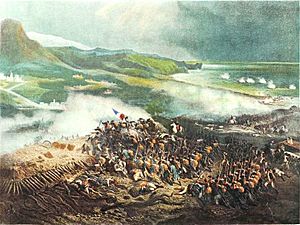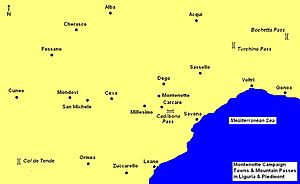Battle of Loano facts for kids
Quick facts for kids Battle of Loano |
|||||||
|---|---|---|---|---|---|---|---|
| Part of the Italian campaigns in the War of the First Coalition | |||||||
 Battle of Loano, by Hippolyte Bellangé |
|||||||
|
|||||||
| Belligerents | |||||||
| Commanders and leaders | |||||||
| Strength | |||||||
| 25,000 | 18,000 | ||||||
| Casualties and losses | |||||||
| 3,000 | 7,000 48 guns |
||||||
The Battle of Loano was a big fight that happened on November 23–24, 1795. It was part of the War of the First Coalition, a conflict where several European countries fought against France. In this battle, the French army, called the Army of Italy, was led by General Barthélemy Schérer. They faced off against a combined army of Austrian and Sardinian soldiers, who were led by Olivier, Count of Wallis. The French army won this important battle.
Contents
Why the Battle Happened
In September 1795, General Schérer took over command of the French Army of Italy. He was up against about 30,000 Austrian soldiers and 12,000 soldiers from Piedmont, a region in Italy. These two armies were led by Joseph Nikolaus De Vins and Benedetto of Savoy, Duke of Chablais. Even though they were allies, the Austrian and Piedmontese armies didn't always get along perfectly.
Leaders in Paris, France, really wanted General Schérer to attack. A young military planner named Napoleon Bonaparte also pushed for this attack.
The Armies and Their Challenges
The French army had about 40,000 soldiers. However, they were struggling. They didn't have enough food, good clothes, or ammunition. This was because the British navy had stopped their supply ships from reaching Genoa. Many French soldiers didn't even have shoes, so they wrapped their feet in cloth.
The Austrian and Sardinian army was larger, with about 53,000 soldiers. They had strong defenses built along the coast near Loano and in the Piedmont mountains. These defenses included trenches and 100 cannons, making them seem very hard to attack.
Planning the Attack
General Schérer was new to the area, so he asked his more experienced generals for help with the battle plan. General André Masséna was known as the most skilled, so he was put in charge of planning the attack.
Just before the battle, a lucky ship managed to get past the British warships. It brought 100,000 biscuits and 24,000 pairs of shoes! This really boosted the soldiers' spirits. The shoes were given to those who needed them most, but many soldiers still went without. One old soldier joked that after the battle, the enemy would have to supply them with shoes.
On November 17, a French division led by General Étienne Charlet launched a surprise attack. They destroyed enemy trenches and captured three cannons and 500 prisoners. Bad weather then forced Masséna to change his plan. He decided to attack the enemy's middle positions, break through them, and then attack other enemy spots from behind. Masséna himself was to lead this daring plan.
Just before the main attack, on November 22, the Austrian commander, De Vins, said he was sick and gave up his command. General Wallis then took over the combined Austrian and Sardinian armies.
The Battle of Loano
The French army launched three attacks. One was a fake attack to distract the enemy, and the other two were real. General Pierre Augereau led the French right side to attack the enemy's left flank near Borghetto Santo Spirito. Meanwhile, General Jean Sérurier and the French left side kept the enemy busy near Ormea.
Masséna's Bold Move
On the evening of November 22, General Masséna set out from Zuccarello with two divisions to attack the enemy's center. At dawn, he gave a short, encouraging speech to his troops, telling them victory was in their bayonets. Then, they charged!
Masséna's troops quickly captured all the enemy positions up to Bardineto. The Austrians fought back fiercely there. Masséna was annoyed by the delay, so he brought in his reserve troops, and the fight became even more intense. General Étienne Charlet bravely charged the first enemy trenches but was badly wounded and died. His death made the French soldiers furious. They charged forward in a tight group with their bayonets, completely defeating the enemy.
Augereau's Success
At the same time, General Augereau successfully attacked the enemy's left side, from Loano up to the heights held by General Eugène-Guillaume Argenteau. His troops captured positions one by one. A stronger defense came from the grand Castellaro, where General Mathias Rukavina and his 1,200 men were. Augereau demanded that Rukavina surrender. Rukavina refused to surrender without being allowed to leave with his weapons and supplies. Augereau gave him 10 minutes to surrender completely.
Rukavina refused. He bravely led his men out of their fort, charging fiercely at the French troops. This surprised the French, who admired the Austrian general's courage.
The Storm and Retreat
The Austrian and Sardinian forces tried to regroup at Mont Carmelo, hoping to win after 10 hours of fighting. General Schérer advanced with his right wing but hesitated, unsure what had happened to Masséna in the center. After getting a message from Masséna, he continued his advance. Suddenly, a thick, wet fog with snow and hail came down, making it dark and stopping the pursuit. Many soldiers were knocked over by the storm, and some died or were wounded by the weather, not the enemy.
The Austrians used the storm to escape, leaving behind cannons, ammunition wagons, and tents. Augereau chased them with light troops. Masséna also kept moving forward, and his troops occupied the mountain passes of Saint-Jacques. The Austrians were left with only difficult mountain trails to retreat.
Sérurier's Victory and Aftermath
Meanwhile, General Sérurier attacked the Austrian and Sardinian right wing on November 23 and 24. He launched a powerful attack on the Piedmontese army, completely defeating them. He captured all their cannons and forced them to join the remains of Argenteau's forces at a camp in Ceva.
Out of 25,000 French soldiers, about 2,500 were killed or wounded, and 500 were captured. The allied forces (Austrian and Sardinian) had 18,000 troops. They lost 3,000 killed or wounded, and 4,000 men and 48 cannons were captured.
The French victory was mostly thanks to General Masséna's bold planning and actions. However, the French didn't follow up on their win very well because General Schérer was too careful, and winter weather arrived. Soon after, both armies settled into winter camps. Still, the Battle of Loano was important because it allowed the French to get new supplies and gave them a strong position in the Ligurian Alps. This position would be used by General Bonaparte in April 1796 during the Montenotte Campaign.
Sources


